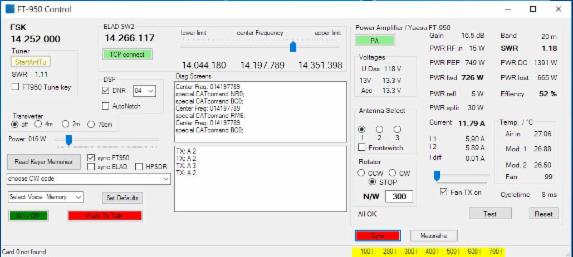Here you find some pictures of my last ham projects
Red Pitaya SDR Transceiver with 5 Watt output
35MHz
low pass filter, the relais for RX / TX switch and the attenuatur are
mounted on the downside of the double sided copper PCB.
The red "Red Pitaya" PCB is a little bit hidden by the copper PCB. 5W- PA was designed by DL2EWN.
Later
I added the 4 bit control for switching the different HAM bands and
connected these to the Sub-D-9pin connector. Which is connected to PA,
described below. 5W input delivers about 250W output.
For all switching purposes I used recycled 6N139 optocouplers, which are able to drive relais currents directly.

OpenHPSDR v3.3.7 and ELAD FDM-SW2
MOSFET power amplifier using 2 modules
with IXYSRF IXZ2210N50L Z-MOS supplied with 120 VDC.
I love big analog instruments :-)
The power supply offers every voltage between 20V and 120V @ 13Amps (20A in peaks) and additionally 13.5 Volts @ 16 Amp
Backside view of the PA:
The device is controlled by an Arduino Mega (Atmel microcontroller ATmega2560 ) with Ethernet shield,
offering full control by Webbrowser or an own developed C#- application based on Windows.
(Over current and antenna mismatch protection is provided by analog hardware)
The example below shows only one module active (-6dB input attenuation)

The FT-950 transceiver can be worked remotely and the aim was
controlling antenna selection and rotator remotely also.
(this can be done by the web frontend above by a smartphone now)
Software
Later on I did some C# code which enables some more features for controlling and synchronizing the different devices.
The first idea for all this was to use an ICOM AH3 antenna tuner together with the Yaesu rig.
The last edit was, to show the wasted harmonic power, which is leaded to a 50Ohm dummy by the split filter. The Arduino inside of the PA switches off, if there is more than 30W wasted!
CAT
- FT-950 is connected via USB to serial adapter
- ELAD Software V2 is connected via TCP (on local device)
- OpenHPSDR connects via virtual COM port (com0com - serial port emulator)
- PowerAmp communicates via Arduino Mega & Ethernet shield
The developmat was done by use of MS Visual Studio 2015.
I'm using Windows 10 / 64bit.
The hardware is a 12" laptop with Intel(R) Core(TM) i5-2520M CPU @ 2.50GHz and 4GB RAM



